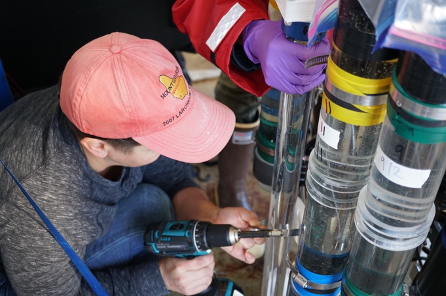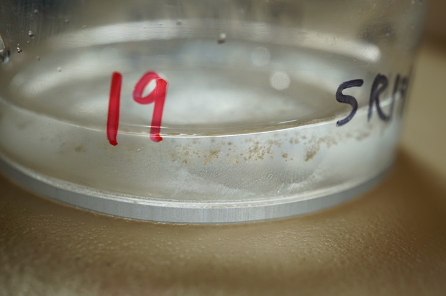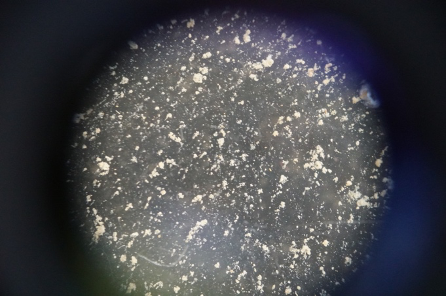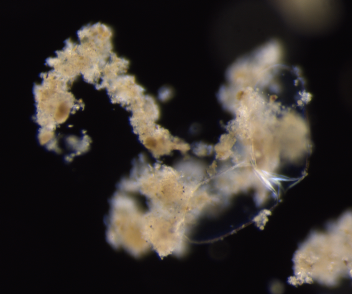Blue Notes, Part 2: Oceanography as a Patiently Put Together Mosaic
May 14, 2020
In this post, Professor Melody Jue (University of California, Santa Barbara) discusses her observations during a research cruise in the Santa Barbara Channel. This is the second entry in the Blue Notes Series, edited by Aylin Malcolm. You can read the series introduction here and Part 1: Wet Globalization in Viral Times (by Steve Mentz) here.
In December 2019, I had the pleasure (thanks to an invitation by Dr. Alyson Santoro) of joining an oceanographic research cruise on the R/V Sally Ride, a research vessel managed by the Scripps Institute of Oceanography in San Diego, California. While this was an unusual opportunity for an English professor, it gave me the chance to observe the knowledge-making practices of oceanography in the field. As an alibi for occupying a bunk, I decided that I would be the photographer/documentarian for the cruise, providing a bank of usable media for the scientists and students. Yet even this was a cover for an experiment of my own: testing whether or not oceanography, as I saw it, was like a mosaic.
Ocean historian Helen Rozwadowski had tipped me off to a key passage in the writings of John Murray—one of the naturalists aboard the HMS Challenger expedition—who once compared oceanographic research to mosaic composition:
It has often been said that studying the depths of the sea is like hovering in a balloon high above an unknown land which is hidden by clouds, for it is a peculiarity of oceanic research that direct observations of the abyss are impracticable. Instead of the complete picture which vision gives, we have to rely upon a patiently put together mosaic representation of the discoveries made from time to time by sinking instruments and appliances into the deep, and bringing to the surface material for examination and study.
Murray’s reflections—so poetically attuned to the opaque medium of the ocean—gesture to the limitations of vision as a means of sensing what lives in the sea. To try and understand what is happening in deep and cloudy water, oceanographic science deploys a variety of instruments. These instruments provide individual observations and samples: a flask of water, a captured organism, a scoop of mud. Each piece—each sample, or each observation—may be carefully assembled into a broader mosaic picture of what was happening in a part of the ocean, at a particular time. The PIs of the R/V Sally Ride Cruise, which was only a week, saw the cruise itself as contributing a few new “pieces” to a decades-long history of observations in the Santa Barbara Channel. Within this short time frame, Dr. Morgan Raven (PI) explained that the challenge would be evaluating how much significance to attribute to each observation; something else could always be going on in the place that you didn’t sample, or didn’t look. It was tempting for me to think of the following analogy: oceanographic knowledge is a mosaic, but the ocean is continuous; oceanographic knowledge is digital, but the ocean is analog.
There is also something about the hand-assembly of the mosaic that connects with oceanographic field work. I was surprised by the high degree of carpentry and last-minute assembly of instruments that took place, as different science teams rushed to attach experimental tubes to the Array, or make fine adjustments in the wooden “snow shoe” attached to the Multi-Core so that it wouldn’t get stuck in gooey seafloor mud (an unwanted anchor!). The word “MacGyver” was freely and frequently tossed around, alluding to the 80’s TV series in which the title character could engineer his way out of any situation with a swiss army knife. On this general level of sampling and assembly, much of work being done on the R/V Sally Ride cruise could be described as mosaic-like, through the craftwork of instrumentation and through the way that sampling itself is like collecting pieces. (There is an ongoing oceanographic cruise whose acronym is MOSAiC [Multidisciplinary drifting Observatory for the Study of Arctic Climate]).




However, what I also observed was that samples weren’t merely collected; they also had to be processed. Great care was taken to keep the deep-sea mud cores in anoxic environments, as teams of student assistants pumped in heavy Argon gas to “cap” the tops of cores. Slices of the mud cores were carefully spooned into small bags, later to be processed and analyzed for their sulfur content. Other data was processed in real time; take for example the CTD rosette (Conductivity Temperature Depth), a device for capturing tubes of seawater at different depths. As the instrument sinks, it relays data about the salinity, temperature, and depth of the water column, which gradually appears on a computer screen graph. One scientist described the experience as “watching a photo develop.”


The connection to photography was even stronger with the “gel traps,” which not only caught marine snow, but preserved the relative position of particles to one another in the three-dimensional medium of the gel. The gel was a snapshot in time, and with the help of a microscope, one could zoom through the dark starfield with abandon, changing focus from copepods to radiolarians, to bits of mucus and fecal pellets. The gel was also itself the subject of photography. One of the scientists aboard the cruise, Dr. Colleen Durkin, had a habit of meticulously photographing the gels with a high-resolution camera, one corner of the petri dish at a time. She would then suture the squares together, careful to make sure each seam was correctly aligned.The result was a series of exquisite photomosaics, with softly visible edges (gradations of black and gray).
If oceanographic fieldwork in the 19th century was comparable to a patiently put together mosaic, then oceanographic fieldwork in the 20th century is perhaps more aptly a photomosaic, each sample a snapshot in time, fixed in place and then assembled into a frame to slowly reveal a picture of the undersea.
(All image credits to Melody Jue, 2019)
Melody Jue is Assistant Professor of English at UC Santa Barbara. She is the author of Wild Blue Media: Thinking through Seawater (Duke University Press, 2020) and the co-author of Saturation: On Elemental Mediation (forthcoming with Duke University Press). Her articles have been published in Grey Room, Configurations, Animations, & Women’s Studies Quarterly, as well as the collections Media & Risk, Green Planets: Science Fiction & Ecology, and Scale in Literature & Culture.
